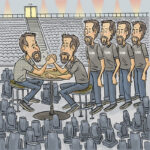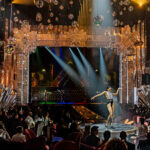Once lighting consoles began to integrate built-in effect abilities, a ballyhoo became as easy as pressing a single button on the screen. This sends the fixtures off in a pre-made, mathematically based movement cycle. The programmer can then adjust the rate/speed and size of the movement effect to help match it to the desired feel and general locations. However, all the fixtures tend to move together along the mathematical trajectory, and thus the movement feels stiff and coordinated. So programmers will adjust the offset of the effect in relation to each fixture. This will cause the fixtures to all be in a different point within the movement path and thus creates a better ballyhoo flow. By properly adjusting the rate/speed, size and offset of a pre-made ballyhoo effect, one can get a reasonably good-looking movement going. However, there is still a great possibility of fixtures moving off into undesired areas of the venue and stage. Further adjustments of the size or base position of individual fixtures may be required to polish a good ballyhoo into a perfect one.
—Brad Schiller, From “Feeding the Machines,” PLSN, April 2016


